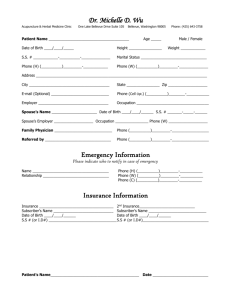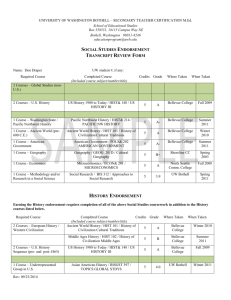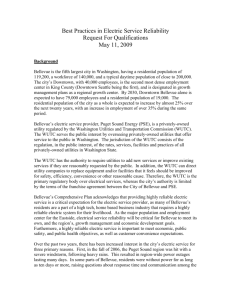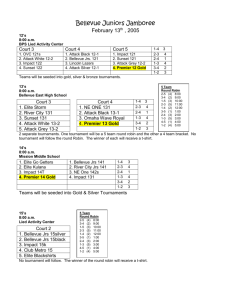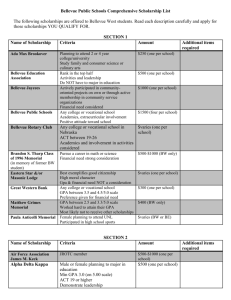World Class Elementary School Math Standards and Textbooks
advertisement
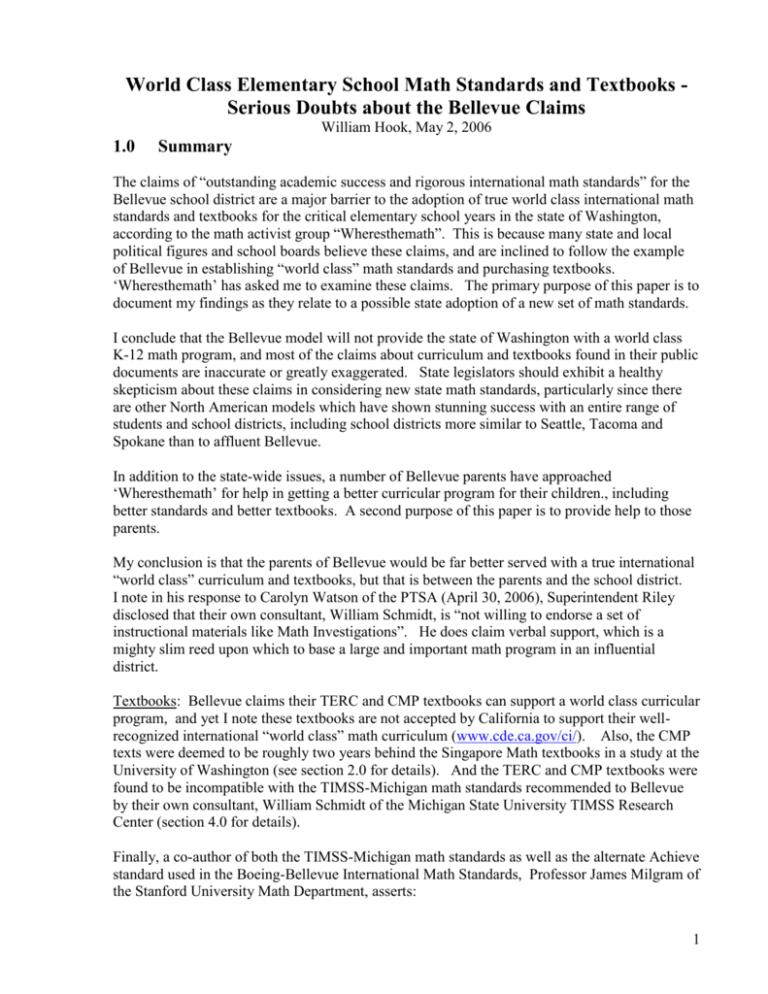
World Class Elementary School Math Standards and Textbooks Serious Doubts about the Bellevue Claims William Hook, May 2, 2006 1.0 Summary The claims of “outstanding academic success and rigorous international math standards” for the Bellevue school district are a major barrier to the adoption of true world class international math standards and textbooks for the critical elementary school years in the state of Washington, according to the math activist group “Wheresthemath”. This is because many state and local political figures and school boards believe these claims, and are inclined to follow the example of Bellevue in establishing “world class” math standards and purchasing textbooks. ‘Wheresthemath’ has asked me to examine these claims. The primary purpose of this paper is to document my findings as they relate to a possible state adoption of a new set of math standards. I conclude that the Bellevue model will not provide the state of Washington with a world class K-12 math program, and most of the claims about curriculum and textbooks found in their public documents are inaccurate or greatly exaggerated. State legislators should exhibit a healthy skepticism about these claims in considering new state math standards, particularly since there are other North American models which have shown stunning success with an entire range of students and school districts, including school districts more similar to Seattle, Tacoma and Spokane than to affluent Bellevue. In addition to the state-wide issues, a number of Bellevue parents have approached ‘Wheresthemath’ for help in getting a better curricular program for their children., including better standards and better textbooks. A second purpose of this paper is to provide help to those parents. My conclusion is that the parents of Bellevue would be far better served with a true international “world class” curriculum and textbooks, but that is between the parents and the school district. I note in his response to Carolyn Watson of the PTSA (April 30, 2006), Superintendent Riley disclosed that their own consultant, William Schmidt, is “not willing to endorse a set of instructional materials like Math Investigations”. He does claim verbal support, which is a mighty slim reed upon which to base a large and important math program in an influential district. Textbooks: Bellevue claims their TERC and CMP textbooks can support a world class curricular program, and yet I note these textbooks are not accepted by California to support their wellrecognized international “world class” math curriculum (www.cde.ca.gov/ci/). Also, the CMP texts were deemed to be roughly two years behind the Singapore Math textbooks in a study at the University of Washington (see section 2.0 for details). And the TERC and CMP textbooks were found to be incompatible with the TIMSS-Michigan math standards recommended to Bellevue by their own consultant, William Schmidt of the Michigan State University TIMSS Research Center (section 4.0 for details). Finally, a co-author of both the TIMSS-Michigan math standards as well as the alternate Achieve standard used in the Boeing-Bellevue International Math Standards, Professor James Milgram of the Stanford University Math Department, asserts: 1 -“there is no way at all that TERC could match up to more than 5 - 10% of the standards in either document.” (section 4.3). Test Results: On the critical 4th grade statewide WASL tests, for the four year period 2000 through 2004, the Bellevue improvement appears to be a negative (-) 9.2 percentage points (Percent Meeting Standard) when normalized to the Washington state score. This even though their percentage of economically disadvantaged students (EDS) at 19% is much lower than the state at 36% EDS. In fact even urban Seattle at 40% EDS did better than Bellevue over the same 4 year period at negative (-) 3.1 percentage points. Another way to evaluate the results of the WASL tests is to determine how well the elementary schools are preparing the students for middle school math. A crude measure of this factor can be obtained by evaluating the improvement in scores of cohorts of 4th to 7th grade students. On this basis, Bellevue performance appears to be somewhat worse than the entire state of Washington. It is hard to see how the performance of Bellevue elementary schools can be characterized as an outstanding academic success when on both the above measures, their indicated performance improvement is poorer than the state average even though their % EDS is far lower. Details of this issue can be found in section 3.0 of this document, including some additional notes on the effect of outside tutoring on the WASL scores in a well-off district such as Bellevue. Finally there are the TIMSS comparison tests administered by William Schmidt and his associates and documented in their formal report to Bellevue in March 2004 (see section 5.0 for detailed quotes about the curriculum analysis and test results from this report). The following quote is found in their report: The performance level of Bellevue’s 11th and 12th grade students was equal to 8th grade students in the composite of the top achieving countries. Standards: In support of their desire to continue to use TERC and CMP, the Bellevue WA school district has made the following claims regarding the quality of their math standards. “The Boeing-Bellevue International Math Standards are based on two sets of K-8 math standards, both aligned with rigorous international standards . . . Taking the best of each, BSD math curriculum lead Eric McDowell synthesized these math standards into a complete whole, creating the Boeing-Bellevue International Math Standards. The Math Standards contain the best thinking on K-8 math instruction existent worldwide.” Yet a detailed examination of the Bellevue published literature paints a vastly different picture. One of the standards Bellevue used was the TIMSS-Michigan standards which had been recommended to them by Professor Schmidt. However Bellevue emasculated that standard by removing a critical column of comments before incorporation into their own standard. One of the lead authors of the TIMSS-Michigan standard, math Professor James Milgram of Stanford University, asserts: “ the comments made it impossible to, with any honesty, use texts like TERC and claim they align, but without the comments, one could use most anything” In addition, inconvenient individual standards from the TIMSS-Michigan standards seem to be completely left out or greatly reduced in scope. 2 The other standard Bellevue used was an unfinished, untested and controversial draft standard originally funded by Achieve, Inc. This draft standard now seems to be abandoned by both Achieve as well as by the academics who were contributing to it. Regarding the history of these standards, the original TIMSS-Michigan standard was a melding of the TIMSS international “Quality” curricula from Singapore, etc. and the California Key Standard curricula. Both have been successfully used and tested for years with matching textbooks on hundreds of thousands of students. On the other hand, the Achieve standard has never been adopted by any state, has no classroom testing nor field evaluation, never used with a textbook, and is still an unfinished draft by the admission of lead writer Lynn Arthur Steen. Neither the emasculated TIMSS-Michigan standard nor the Achieve standard can, by any stretch of the imagination, be considered rigorous and world class. It would appear the new Bellevue standard was written to more closely match the TERC and CMP textbooks, rather than the other way around. And even with these greatly reduced standards, it is understood that Bellevue is requesting additional support from Boeing to create supplemental lessons. Details of this matter can be found in section 4.0 and 5.0 of this document. All the above suggests any jurisdiction which is considering the Bellevue model and using the TERC and CMP textbooks should perform a detailed examination of the Bellevue story before proceeding. This study of the Bellevue claims is based entirely on published Bellevue literature found on their website or on Washington state websites. I welcome critiques of this draft document, as I recognize there may be other written and publicly available sources which I am not aware of. I also wish to acknowledge the contributions of William Schmidt and the TIMSS Research Center at Michigan State University in their 2004 report on the Bellevue School District. I find no conflict between their recommendations for improvements, made in 2004, and our present conclusions (see Section 5.0). 2.0 Middle School Mathematics Comparison – University of Washington In March 2001, the Department of Applied Mathematics at the University of Washington published a summary of their NSF report “Middle School Mathematics Comparisons for Singapore Mathematics, Connected Mathematics Program, and Mathematics in Context.“ Highlights from the conclusions section of that report include: Page 50: “The Algebra level in CMP and MIC appear to be almost two grade levels lower than in the Singapore materials “ Page 51: “Finally, we return to the questions raised by the TIMSS study alluded to in our Introduction. Is the Singapore curriculum in mathematics responsible for its students' top ranking in the TIMSS tests? Is the abysmal performance of American middle and high school students in the TIMSS tests attributable to flaws in the American mathematics curricula? 3 Would American students' performances move to the top if only we adopted the Singapore curriculum here? Of course, if the TIMSS tested rote memory, recall of facts, and manipulation skills, Singapore students would have an edge over American students; their curriculum emphasizes practice problems and makes sure that the students attain fluency and computational skills at a level we judge to be one to two grades higher than their American counterparts. However, the TIMSS tests were designed to test understanding of concepts in addition to competency. . . . . . we must acknowledge that Singapore's educational system . . . has succeeded in producing students who as a whole understand mathematics at a higher level, and perform with more competence and fluency, than the American students who took the tests. 3.0 WASL Improvement Performance – Bellevue, North Beach, etc. The below graph of 4th grade WASL scores versus year was made for the period Niki Hayes was the principal of North Beach Elementary, and was intended to show the performance of a Seattle school which employed Saxon Math. The performance of North Beach was certainly credible, climbing from 68% to 91 % in the 4 year period, particularly since the Saxon books are not directed toward WASL content. 4th G rade W AS L Im provem ent at No rth B each E lem e ntary During the N iki Hayes-Saxo n M ath Adm inis tratio n Percent Meeting Standard 10 0 90 + 2 2 % P oin ts S ax o n M ath 80 70 60 + 9.6 % Points N o rth B e ac h B elle vu e + 16 .1 % P o in ts + 19 .2 % Po ints T ER C 50 S e a ttle W A S tat e 40 NorthBch (11 % E DS) B ellevue (19 % EDS) Seattle (40 % EDS) W A State (36 % EDS) 30 20 199 6 199 8 200 0 200 2 200 4 200 6 200 8 Year Bellevue (TERC/CMP): 350 K-6 students per tutoring facility Palos Verdes Peninsula (Everyday Math): 430 Manhattan Beach (Saxon): 2,100 The more startling data is from Bellevue, which only improved by 9.6 % points in that four year period, even though the state scores improved by 19.2 % points. If it is assumed that scores 4 should be normalized to the state average in order to account for such factors as a changing difficulty of the WASL questions, the Bellevue 4th grade scores actually got worse over that 4 year period by 9.6 % points. Or, making the district-to-district comparison, the Seattle School district did better than the Bellevue School District by 6.5 % points, even though the percent of economically disadvantaged students (EDS), as measure by the number of Seattle free and reduced lunch students, was more than twice as high as Bellevue. Another striking factor in the Bellevue performance relates to tutoring. It is clear that parents in a relatively affluent city such as Bellevue will not let their children fall behind no matter how bad the textbook or curriculum. A rough measure of the degree of parental support is to count how many tutoring services are in business in a particular district. It appears there are 23 such services in the Bellevue district. If one estimates the number of K-6 students at about 8,000, one can calculate there are roughly 350 students per tutoring facility. A similar calculation at a suburban district in Southern California (Manhattan Beach) which was an early adopter of the California international curriculum and has used Saxon Math since 2000, showed there was only one tutoring service for the 2,100 K-6 students, for a ratio of 2,100 students per tutoring facility. Anecdotal reports from parents indicated their children needed a minimum amount of parental intervention. A neighboring school district (Palos Verdes Peninsula), which used the non-approved textbook Everyday Math, had a ratio of 430 K-6 students per tutoring service, a number very similar to that of Bellevue, but at least Palos Verdes managed to almost stay up with Manhattan Beach in terms of their test scores. Bellevue on the other hand, even with its large amount of uppereconomic parental support, did worse than the Seattle District on 4th grade performance improvement. 3.1 A Crude Cohort Analysis: It is unfortunate that the only K-6 WASL data is for the 4th grade, as opposed to California which has yearly scores for the 2nd through the 6th grade, thus allowing the analysis of cohorts of students as they move through elementary school. However, a crude cohort analysis can be made by calculating how much improvement several cohorts of 4th graders had made when they got to the 7th grade, again using the WASL “Percent Meeting Standards” data. This data is given as follows: Bellevue Cohort 4 grade in 2000 62.7 to 7th grade in 2003 55.4 Improvement -7.3 State 41.8 36.8 -5.0 Cohort 4th grade in 2001 to 7th grade in 2004 Improvement 43.4 46.4 3.0 th 64.9 65.8 0.9 We analyzed the cohorts during the same period as the previous analysis. We started with 4th grade in 2000 through 7th grade in 2003, and with 4th grade in 2001 through 7th grade in 2004, and found that in both cases Bellevue did worse than the state. 5 - 4.0 Bellevue Math Standards In 2003 Bellevue hired Bill Schmidt to do a study comparing Bellevue to the TIMSS (paid for by an anonymous $300K donation according to former Bellevue parent Erin Johnson). At roughly the same time the state of Michigan hired Bill Schmidt, James Milgram, Hung-Hsi Wu, Joan Ferrini-Mundi, Glenda Lappan and Paul Sally to create a world class international A+ curriculum for Michigan. The resulting document is titled Mathematics Standards (DRAFT) November 5, 2003, and is the draft of the original document submitted to the state of Michigan by the Schmidt group of curriculum researchers. It represented a melding of the TIMSS “Quality” curriculum described in Schmidt et. al. (2002) and the California Key Standards curriculum written by Milgram, Wu and others at Stanford University. Sometime after Schmidt submitted his TIMSS report to Bellevue, he also submitted the original draft of the recommended Michigan curriculum to Bellevue. There is no way of knowing what his cover letter said, but what seems clear is that Bellevue accepted that Michigan draft as their standard, and to this day when you search the Bellevue site for “Math Standards”, the original Michigan draft, dated November 5, 2003 is what you get. In Bellevue this standard has been referred to as the “TIMSS Math Standards” on the BSD web page and the “PROM/SE standards” on the Belleville Schools Foundation web page describing the Boeing Bellevue International Math Standards Partnership. To avoid confusion we shall call this document the TIMSS Original Michigan Draft Standards, or the “TIMSS-Michigan Draft” for short. It appears Bellevue wanted to continue using TERC/CMP/CPMP even after the receipt of the TIMSS-Schmidt report and the receipt of the TIMSS-Michigan Draft from their own consultant, and despite the fact that those textbooks did not align with the TIMSS-Michigan Draft standards by the Bellevue districts own analysis. (I deduce this based on their actions; if their textbooks supported the TIMSS-Michigan Draft standards they would have simply created a standards map for their textbooks and used the Boeing support money for something more important). In order to support their decision to continue using TERC/CMP/CPMP, it would appear that Bellevue decided to create a whole new set of standards, and turned to, as the source, a set of standards under development by Achieve, Inc., called the Mathematics Achievement Partnership (MAP) K-8 Mathematics Expectations, December 2004 Draft. 4.1 MAP K-8 Mathematics Expectations: The Bellevue Schools Foundation page, which describes the Boeing International Math Standards Partnership, has the following claims about this Achieve standard: It is aligned with rigorous international standards. Not even the Achieve literature makes such a hyperbolic claim. The more accurate representation is, from the Achieve editor: “MAP’s Mathematics Expectations is a very complex document that is now in its fourth or fifth incarnation. Notwithstanding months of scrutiny, many errors and unclear explanations 6 undoubtedly remain; almost certainly, through my editing, I have introduced some new difficulties as well. However, the goal of this draft is not perfection of detail, but to provide a version that responds to the most important concerns raised by reviewers. I hope I have succeeded in that objective.” Lynn Arthur Steen Professor of Mathematics St. Olaf College December 2004 Other negative characteristics of the Achieve standards include the following: No state has adopted these standards yet (to our knowledge, and no claim so by Achieve). This is a set of standards which, as a whole and consistent body, has undergone no testing nor field evaluation (to our knowledge, and no claim so by Achieve). This set of standards has never been used with any textbook. This is a set of standards which is being reviewed by a large set of stakeholders, just like the NCTM standards were, and thus subject to “topic creep” in order to satisfy everyone. It is still just an unfinished draft, by the admission of the lead writer, Lynn Arthur Steen Professor Jim Milgram of Stanford has provided the following historical note on the Achieve standards, dated 10:25 a.m.., March 19, 2006: “The Achieve standards were originally very close to the Schmidt-TIMSS-CA standards you mention below. In fact, our writing of the Michigan standards was very closely coordinated with Achieve. However, the final revisions due to Lynn Steen and Ann Shannon did not match up very well. I believe that Wu was initially involved in the final revision but after a while gave up and withdrew from the project. Jim” Professor Ralph Raimi at the Department of Mathematics, University of Rochester, another coauthor of the Achieve standards, added the following comment, dated 11:12 p.m, Apr 29, 2006: “Those of us who, like Wu, Milgram and me, worked on the Achieve standards were disappointed in the result, but did not consider Steen's final draft, unfinished as it is, to be a disaster. It is not up to the CA standards but it's failings are not at all what is wrong with the Bellevue claim. There is no way that TERC or CMP can come up to a match with the Achieve document, or even 75% of it, maybe not even 50%. Ralph” Based on the Milgram input (Milgram was on the MAP’s advisory panel) and the Raimi comment, it appears that MAP started out with good intentions, but was diluted by the influence of Lynn Steen and Ann Shannon. All the math professor’s who worked on it have withdrawn, 7 and it appears that Achieve, Inc. has lost interest in this unfinished document. There is no more funding available to finish it. In comparison to the Achieve standard, the original TIMSS curriculum embodied in the standards of the six leading nations, and the California Key Standards quality curriculum, reflects the following history: California has adopted and used such a curriculum for over 7 years, and the six leading math countries have adopted and used this curriculum for much longer than that. California has tested students using this curriculum every year for the past 7 years (grades 211), and the six leading math countries have tested their version in the TIMSS studies of 1995, 1999 and 2003 (grades 4, 8, 11). California has adopted and used two well-aligned textbooks with this curriculum for the past 6 years, and the six leading math countries have used at least 2 aligned textbooks each since well before 1995. California Key Standards were designed by a small focused group of Stanford University math professors who had no desire to please anyone in the math education establishment. California Key Standards and supplementary material was published in book form in the Mathematics Framework, 2000 Revised Edition (ISBN 0-8011-1508-6), with additional explanatory information added in the 2006 revision. In summary, the current Achieve MAP Standards document is still a work in progress, has been adopted by no states and has never been field tested to our knowledge. The Achieve document also has never been tested with a matched textbook. It is clearly a questionable reference for the use of a jurisdiction such as Bellevue, which aspires to a world class math curriculum, when at least two far better standards are available, namely the California Key Standards and the TIMSSMichigan Draft standards. 4.2 The Boeing Bellevue International Math Standards Partnership: The program overview, found on the Belleview Schools Foundation website, makes the following claims: The Boeing-Bellevue International Math Standards are based on two sets of K-8 math standards, both aligned with rigorous international standards. One set is the PROM/SE standards (the TIMSS-Michigan Draft), developed by TIMSS; the other set is the Achieve standards, developed by Achieve, Inc, . . . . . Taking the best of each, BSD math curriculum lead, Eric McDowell, synthesized these math standards into a complete whole, creating the Boeing-Bellevue International Math Standards. The Math Standards contain the best thinking on K-8 math instruction existent worldwide. I attempted to re-create the synthesis process used by McDowell, and came to the following conclusions: 8 Some of the new standards appear to be lifted from the TIMSS-Michigan Draft, but in all cases the 3rd column of comments (the “Remarks” column) seem to have been left out. According to Jim Milgram, one of the authors of the TIMSS-Michigan Draft, these comments must be included and are an essential component of each individual standard. “The reason is that the comments made it impossible to, with any honesty, use texts like TERC and claim they align, but without the comments, one could use most anything.” (see section 4.3 for complete quote). In essence, McDowell seems to be using the TIMSSMichigan Draft as one source, but that source has been emasculated by the removal of the essential comments governing the selection of matching textbooks. The Achieve standards also have many notes and examples. Few of these seem to have been included in the new Bellevue standards. One might conclude that McDowell is also using an emasculated version of the Achieve standards as a reference. Inconvenient standards seem to be completely left out or greatly reduced in scope. I made a detailed comparison of the Algebra strand in the sixth grade, and found fourteen (14) individual standards or sub-standards in the TIMSS- Michigan Draft standard. In comparison I found only four (4) sixth grade Algebra standards or sub-standards in the new Bellevue standards. These standards were a good deal less specific than what is found in either the TIMSS-Michigan Draft or the Achieve standards, and all lacked the comments necessary to guide the proper selection of a matching ‘world class’ textbook. The general scope of the individual Bellevue 6th grade Algebra standards were much less than found in the TIMSS-Michigan Draft, thus depriving the Bellevue students of the rigor of the demanding topics which Schmidt (2002) concludes are essential for a world-class (“quality”) curriculum. Based on the analysis given in the previous section plus the historical comments of Professors Jim Milgram and Ralgh Raimi, it appears the statements italicized and highlighted in blue above are far from accurate. Bellevue has (a) in essence used an emasculated version of the TIMSSMichigan Draft to allow TERC and CMP to qualify as meeting individual standards from that document , (b) used an emasculated version of the Achieve document for the same reason, a standard which is not even finished nor tested and (c) completely left out inconvenient demanding standards. Neither the emasculated versions of the TIMSS-Michigan Draft nor the Achieve standards, used by Bellevue as sources, can be considered “world class” by any stretch of the imagination, and certainly not the resultant Boeing-Bellevue International standard with its emasculated or untested source material and its missing inconvenient demanding standards. 4.3 Quotes from Professor Jim Milgram, Stanford University, co-author of the Michigan-TIMSS Math Standards and the early versions of the Achieve Standards, regarding Bellevue Professor Jim Milgram from Stanford was one of the mathematicians who worked on both sets of standards referred to on the Bellevue Schools Foundation website, under the heading “Math: The Boeing Bellevue International Math Standards Partnership”. The two sets of standards are the TIMSS-Michigan draft (the PROM/SE Standards in the Bellevue site) and Achieve. Here are 9 several of Dr. Milgram’s statements to Shalimar Backman of “Wheresthemath” via various emails regarding these two standards: [in regard TIMSS-Michigan] “These are the ORIGINAL standards that we helped write for Michigan. The "standards" were adopted verbatim in Michigan, but there is a crucial column of comments that Bill Schmidt has assured me are present in the document you found on the Bellevue site, which were deleted from the Michigan standards by the dark force. The reason is that the comments made it impossible to, with any honesty, use texts like TERC and claim they align, but without the comments, one could use most anything.” [Both Standards] “The thing to focus on with Bellevue is that the teachers are fooling themselves if they think TERC handles any of the significant features of these standards properly. This is one of the constant failures that, over the years we've had to deal with. Just because a topic is casually mentioned in a text does not mean it is covered, and teachers only betray the ignorance that is the cause of student's abysmal performance when they say otherwise.” [TIMSS-Michigan] “Then the question is who are the teachers that "evaluated" TERC against the Standards that Bill Schmidt gave to the district. It's too easy to go along, and maybe necessary for the teachers that claim to supplement. But some teachers had to lend their names to the claim that TERC matches up against these standards. These are the teachers that are the major problems. Flatly, there is no way possible that an unbiased evaluation of that program would get it to match up against any of the standards at Grade level.” [TIMSS-Michigan) “We had already written this set of A+ standards for Michigan in 2003. What Bill gave Bellevue was the ORIGINAL document that we had produced. The last column was deleted by the dark force in Michigan, and without that column the standards could be interpreted as supporting all sorts of things that they weren't meant to support.” [TIMSS-Michigan] “As far as I understand the situation from Bill Schmidt, the standards that Bellevue is using are exactly the standards we wrote without changes. What appears to have happened is that some people have claimed that these standards are supported by TERC. This is simply not true.” [Both Standards] “You have to understand that there are two types of comparison with standards. There is the superficial comparison that announces that a standard is met if it is mentioned in the text and the comparison that insists that the standard content of that standard be fully represented in the text. If the latter is the method used - and it is the method used in California - then there is no way at all that TERC could match up to more than 5 - 10% of the standards in either document.” 4.4 Quote from professor Ralph Raimi, University of Rochester Department of Math and co-author of the unfinished Achieve Math Standards: “The Achieve standards are incomplete, yes, but they are not inferior standards. It is not the substitution of the Achieve items for the TIMSS-Michigan ones that makes it possible to pretend that TERC and CMP match world-class standards. The apparent matching is the result of Bellevue's merely dropping almost all the inconvenient standards. They don't even “say” they really follow any world-class standards, whether CA or Achieve or TIMSS-Michigan; they say 10 they "took the best elements" from world class standards, or took a consensus view, or some flaky thing like that. Those of us who, like Wu, Milgram and me, worked on the Achieve standards were disappointed in the result, but did not consider Steen's final draft, unfinished as it is, to be a disaster. It is not up to the CA standards but it's failings are not at all what is wrong with the Bellevue claim. There is no way that TERC or CMP can come up to a match with the Achieve document, or even 75% of it, maybe not even 50%. Look at the discussion of irrational numbers in the Achieve document and try to find anything like it in CMP.” 4.5 Conclusions regarding the Bellevue curriculum: A charitable interpretation of all the above is that the math experts working for the BSD were woefully uninformed about international math curricula, had not read the excellent summary paper by Schmidt et. al. (2002), and had no knowledge of the related developments in California, despite the fact that two of the persons whom they knew to have written the TIMSS-Michigan Draft standards were from California. A more cynical interpretation would be that the math experts working for BSD took the convenient portions of both set of standards and synthesized them into a version which best matched the content of the TERC/CMP/CPMP textbooks. If the BSD truly believed what they said above about wanting a curriculum “aligned with rigorous international standards,” they would immediately adopt either the Schmidt recommended TIMSS-Michigan draft set of standards or the California Key Standards. At a minimum, they would also carry out a smooth transition by buying matching textbooks and start using this international curriculum with students in grades K-3. Either Saxon Math or Singapore Math are suitable as well-tested textbook series. In addition, California has a number of adopted textbook series which could be used, although none but Saxon Math has enough test history to claim statistically valid success for their pedagogy. Also, California has an excellent Math Framework document with suggestions for students struggling with Algebra, and an elaborate matched testing system in place. 5.0 “Improving College Readiness, A Profile in Math & Science Education in the Bellevue School District”, March 2004 (The Schmidt final report to Bellevue on his consulting contract) This report describes the results of TIMSS-type tests given to Bellevue students by the Schmidt team of consultants, and the results of their evaluation of the preliminary district math standards. No mention of the TERC/CMP/CPMP textbooks used at that time in Bellevue was found in this report, nor of any other textbooks. The Schmidt report rightly gives great credit to Bellevue for the job they had done in starting to create a District math standard to replace the dysfunctional Washington state math standard, and for making this standard accessible to the parents. It would appear that the lack of mention of the textbooks was taken by the Bellevue School District and others as a ringing endorsement of the TERC/CMP/CPMP textbooks. 11 But a close reading of the specific statements regarding test results, copied in section 5.2, does not support this interpretation. After all, it is ultimately the textbooks which provide the learning, not the standards. It is not possible for a rational reader to conclude the textbooks were just fine based on the following statement from section 5.2 below, as well as the many other damning statements: The performance level of Bellevue’s 11th and 12th grade students was equal to the 8th grade students in the composite of the top achieving countries. The sum of all the below statements, in combination with the fact that Schmidt sent Bellevue the TIMSS-Michigan Draft standards shortly after he submitted his final report, clearly indicates that Schmidt concluded Bellevue was far from world class in 2004 in regards both standards and performance. We have found no written comments from Schmidt regarding the progress which Bellevue has made in rectifying the problems he identified in the 2004 report. There are various reports of verbal statements Schmidt has made regarding these issues, but we can only use written and publicly available reports for this sort of document. 5.1 BSD Content Standards, Math (page 7) – Quotes: Bellvue’s math standards are more focused than the Washington standards, and also begin to reflect the coherence and rigor evidenced in the top achieving TIMSS countries. However, while no topic was covered in all eight grades by a 2/3 majority of the top achieving countries, several topics were intended to be covered in all eight grades by Bellevue students (whole number operations; data representation and analysis; estimating computations; patterns, relations, and functions). Furthermore, many topics remained in the curriculum for significantly longer periods of time, either by being introduced earlier or intended in later years (common & decimal fractions; percentages; coordinate geometry; negative numbers; number theory; exponents; congruence; similarity; slope and trigonometry) Other topics were introduced quite late during the elementary or middle school years, at least as defined internationally (equations & formulas; basics of two dimensional geometry; proportionality concepts; proportionality problems; properties of both whole number operations and fractions and decimals) Perimeter, area and volume were intended earlier in the Bellevue curriculum (obviously less formally), but did not receive much coverage in later years – especially during the middle school grades – when these areas are heavily covered in the top achieving countries. Intended coverage of proportionality concepts and proportionality problems was also less compared to international standards. Other topics not covered at all during the elementary or middle school years: rounding and significant figures; estimating quantity and size; measurement (estimation and errors); constructions using straightedge and compass; rational numbers and their properties. 12 The over coverage of whole number operations and data representations when coupled with the lack of coverage of geometric constructions and the properties of rational numbers should be looked at, as the consequences may be serious, especially as the students move to high school Also, another pattern in need of serious consideration is the systemic under coverage of properties related to basic arithmetic such as the properties of: whole number operations; fractions and decimals; and the rational number system. The import of these comments can only be understood by a study of Schmidt et. al (2002). 5.2 Curriculum Related Indicators (Test results indicating curriculum issues) – Page 9 Display 14 shows the top achieving countries outperforming the Bellevue students at both 7th and 8th grade. In fact the gap between Bellevue students and the top achieving students remained relatively constant. 10th grade students in Bellevue performed almost as well on the TIMSS grade assessment as grade 8 students in the top achieving countries. By the end of 12th grade around 70 % of the Bellevue students can solve a typical 8th grade item on the TIMSS test. By these estimates around 30 % of the Bellevue students are being left behind, especially since these are 8th grade items reflecting more a level of mathematical literacy and not a level of mathematical competence necessary for more advanced study. The performance level of Bellevue’s 11th and 12th grade students was equal to the 8th grade students in the composite of the top achieving countries. Another conclusion from Display 14 is that little additional learning is reflected by the Bellevue student population on the TIMSS 8th grade assessment beginning in grade 10. While raising questions about the high school curriculum, this emphasizes the importance of the mathematics curriculum prior to high school and, perhaps, the particular importance of the middle school curriculum in terms of developing quantitative literacy. Appendix - How to find the various math standards mentioned in this document The various descriptions of the two original curricula and the version modified to match the TERC/CMP textbooks can be verified at the following locations. Also included is the link to the formal Schmidt 2004 report to Bellevue, the basic Schmidt (2002) curriculum paper, and the state WASL score site: 13 1. TIMSS Original Michigan Draft Standards, or the “TIMSS-Michigan Draft” for short. http://www.bsd405.org/default.aspx?tabid=688 (pdf file is located at the bottom of the announcement) 2. Achieve Standards: Open the 2nd attachment of the email of which this document is the 1st attachment (Achieve standards.pdf) 3. Boeing-Bellevue International Math Standards http://curriculum.bsd405.org/C13/C6/Math/Lists/Standards%20Mapping/AllItems.aspx 4. Schmidt 2004 Final Report to Bellevue “Improving College Readiness” http://www.bsd405.org/default.aspx?tabid=687 5. Schmidt, W., Houang, R. and Cogan , L.: 2002, A Coherent Curriculum, The Case of Mathematics, American Educator, Summer 2002 Issue http://www.aft.org/pubs-reports/american_educator/summer2002/curriculum.pdf 6. WASL Scores: Google “OSPI Washington”, click on Washington State Report Card, then click on Summary 14
